
Background information
Huawei is releasing an 8K TV with 5G – really?
by Luca Fontana

8K TVs are causing a stir in the TV industry. But there are two problems: the lack of 8K content and the low bandwidth. At least for the latter, we should already have found the solution: 5G.
5G is on everyone's lips, including the TV sector. This new ultra-fast mobile phone standard is set to enter the 8K TV industry soon. We already told you about Huawei's 8K 5G TV plans back in May.
Sharp has presented similar plans at IFA Berlin: the Japanese manufacturer even wants to exploit the entire 8K production process with hardware and software solutions - from camera to playback device to processing software. In a press release issued by SK Telecom - one of South Korea's largest telecommunications companies - Samsung also announced the upcoming arrival of 5G-enabled 8K TVs in the Asian market.
Excitingly, this will be the first time TVs have been built that can connect to the mobile network. The reason: bandwidth.
5G should therefore simplify the data path between ISPs and TV and, symbolically speaking, turn the path across the field into an eight-lane motorway. Swisscom, for example, has brought better bandwidth to many homes in Switzerland by expanding its fibre network. In practical terms, you can visualise bandwidth as follows:
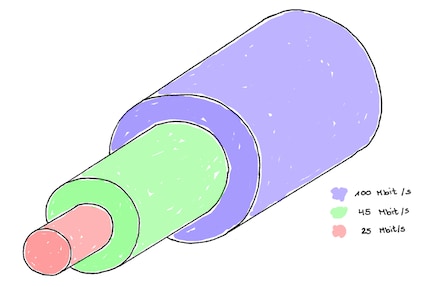
The problem: laying, operating and maintaining fibre optic networks - or at least decent copper wires - across the country is tedious and, above all, expensive. Residents of the St. Gallen community of Eggersriet are still waiting to have the internet installed at a speed of at least 80 megabits per second. However, Switzerland is still one of the best-connected countries. If we look at the fibre optic network on a global scale, it's even more complex. In China and the United States, for example. It will probably be decades before the majority of homes in these countries are connected to the high-speed cable internet network.
.
In addition, there are many infrastructure bottlenecks that limit the bandwidth available in your home. Take this example: Samsung wants to send you a packet of data scaled up to 8K on a South Korean server.
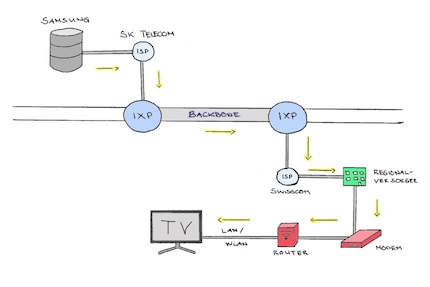
For clarity: the Samsung server is connected via a South Korean ISP (Internet Service Provider) such as SK Telecom to an Internet backbone. Transmitted via the Internet backbone, the data packet reaches a Swiss ISP in Switzerland. In our example, Swisscom. Between the two ISPs in South Korea and Switzerland, there are numerous Internet exchange points (IXPs), Internet exchange points and nodes in French, which ensure the exchange of data between the ISPs in the Internet backbone.
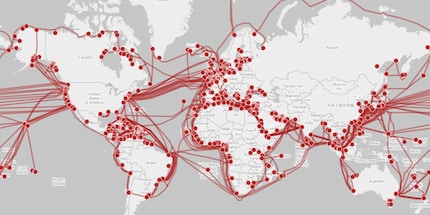
The Swiss ISP then sends the data packet to a regional provider near you. From there, the packet is routed to your home. It then lands in your modem. The modem converts the signal and sends it to the router. The modem and router are often integrated into the same device: your internet box. The router then sends the data packet to your TV via LAN or WLAN to the device modem built into your TV. The device modem processes the signal and decodes the data packet.
If instead of using the internet network, the data packet travels via the mobile network to arrive in Switzerland, our scheme is radically different:
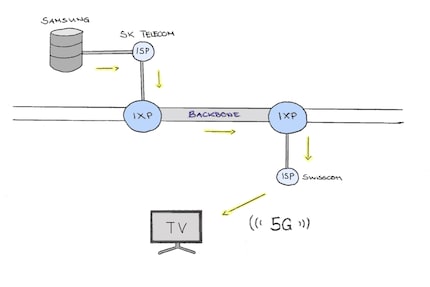
At first, nothing changes. Samsung sends the packet to a South Korean ISP, from there the packet is transmitted to a Swiss ISP via the internet backbone and the many IXPs. Then things get spicy: the Swiss ISP sends the data packet via the 5G network directly to your TV's modem.
That's it.
So not only does 5G have far more bandwidth than fibre, it also has the advantage of far fewer bandwidth-limiting bottlenecks.
Last clarification: the diagrams and processes described above are greatly simplified. The reality is much more complex. But it's enough to understand the benefits of a 5G TV.
Makers of 8K TVs are more concerned about bandwidth than the lack of 8K content. Journalists and experts in the field often criticise manufacturers for advertising 8K TVs, when in fact they are just scaling Full HD and Ultra HD content through powerful processors.
Also, never short of ideas, marketing teams are clever and invent terms like "Upscaling by AI". All this to ensure that the customer is convinced that they are getting quality that is in every way comparable to true 8K. For manufacturers, it's much simpler - and probably also more efficient - for the calculations to be done on servers in South Korea, Japan, Poland or elsewhere, rather than on the TV sets.
On the one hand, this is due to the more powerful infrastructure made available. And secondly, because TV sets would no longer need to compute themselves. TVs would then simply consist of a screen and a stand. It would then be possible to create completely new shapes and designs. The same goes for smartphones: the hardware and electronics could be reduced to the bare minimum, and perhaps even installed directly in the frame. Like Panasonic's transparent OLED TV prototype - with no loss of performance at the expense of picture quality.
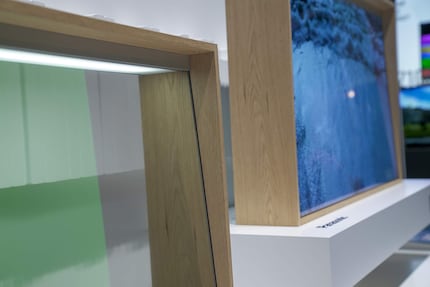
In the eyes of manufacturers, design is becoming almost as important as picture quality, and this is reflected in their marketing campaigns. This is particularly noticeable with TVs such as "The Frame" and "The Serif" from Samsung or with the TV OLED from LG.
But these are just guesses. At any rate, as long as the data packets resulting from the calculations are sent to the servers via the internet within a reasonable timeframe.
Surely, some of the data packets will be sent to the servers via the internet within a reasonable timeframe.
Of course, some data is already exchanged between TV sets and manufacturers via the internet. For example, in the case of the famous AI Upscaling from Samsung or LG. But the lack of bandwidth in the set and in the home network limits the quality of upscaling, which could certainly be better and approach the true quality of 8K if the bandwidth for data transmission were significantly higher.
And even without the servers and upscaling: if, against all odds, Hollywood, Netflix and co were to start producing native 8K content, the bandwidth in most homes would not be sufficient to stream the data directly to the TV. At least, that's what the State of the Internet report published in 2017 by Akamai shows.
TV manufacturers don't yet know what the future technology will be for delivering 8K content to their TVs. Many of them are considering 5G, a standard that could effectively make possible the networking of consumer electronics that manufacturers have been promising for so many years. In a word, home automation. In Huawei's case, the rumour even hints that the 5G adapter will be available in the near future.even suggests that the TV's 5G adapter is both a modem and a router for surrounding home appliances. This would make the 5G TV the focal point of the connected home.
But that's another topic...
I write about technology as if it were cinema, and about films as if they were real life. Between bits and blockbusters, I’m after stories that move people, not just generate clicks. And yes – sometimes I listen to film scores louder than I probably should.
Interesting facts about products, behind-the-scenes looks at manufacturers and deep-dives on interesting people.
Show all